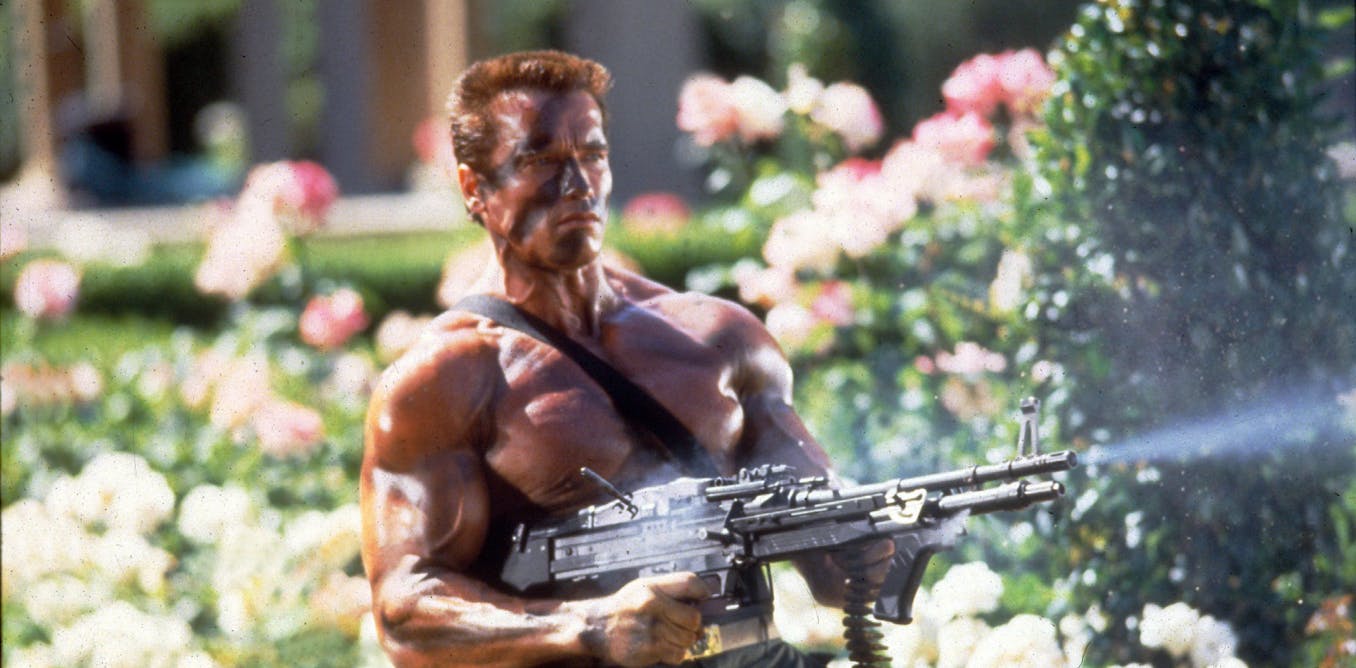Earlier this year I created a video essay about Arnold Schwarzenegger. While making it, I realised that Commando, Schwarzeneggers’ most excessive one-man-army film, was about to turn 40 – so I decided to rewatch it.
I found that the film’s mature age contrasts with its juvenile absurdity, which I absorbed all too easily when I first saw it, far too young, as a pre-teen. It was one of the few VHS tapes I had access to (thanks to an older sibling) and I watched it more than I should probably admit.
By the time The Matrix arrived in 1999, it took genuine effort for me to separate it from Schwarzenegger’s Commando character, John Matrix, the musclebound soldier saving his kidnapped daughter from terrorists, which was deeply etched in my brain. If that setup sounds familiar, you might also be thinking of Liam Neeson’s character in Taken (2008) – a film for which Commando is an obvious blueprint.
Beyond inspiring a wave of rogue hero revenge movies, Commando became a key cultural touchstone for kids on the cusp of adolescence. The film is pretty much the celluloid equivalent of playing with G.I. Joe action figures, only to put them down when you discover computer games.
In The Terminator (1984), Schwarzenegger played a cyborg from the future sent to the present. Meanwhile, Conan the Barbarian (1982), Conan the Destroyer (1984) and Red Sonja (1985) all situated him in the distant, fantastical past of sword-and-sorcery epics. Commando, by contrast, was the first film to present him as a native inhabitant of a recognisably modern setting.
In the film he navigates suburban America, shopping malls and airports – albeit all with his signature ability to casually lift and rip a phone booth out of a wall with someone in it, and jump from a moving plane during its ascent.
Toy soldiers
Commando deliberately introduces Schwarzenegger through his body before anything else. The opening sequence is a montage of close-ups – bulging biceps, ropey veins – before revealing Matrix moving through the woods. He has an entire tree trunk balanced on one shoulder and a chainsaw hanging from the other hand.
Body and machinery appear before character – a choice that feels like a deliberate echo of The Terminator. Schwarzenegger’s expression is almost like an automaton at first, and his movements mechanical, until his daughter Jenny appears and the hardness dissolves instantly into playful melodrama.
That the film’s opening foregrounds Schwarzenegger’s body (returned to again in later scenes) is significant for several reasons. One is that it recalls Thomas Edison’s 1894 “actuality films” of German strongman Eugen Sandow, where the display of muscle wasn’t just part of the film – it was the entire attraction.
The treatment of Schwarzenegger’s body as spectacle is also a reminder of the exaggerated physiques of 1980s toy action figures. Commando arrived just as Mattel’s Masters of the Universe line (1982–present) reached peak popularity, with He-Man, Skeletor and most of the range sharing the same hyper-muscular form.
There’s a persistent misconception that the Masters of the Universe toy line began as a Conan the Barbarian tie-in, hastily reworked once the film was deemed too adult for children. In reality, events unfolded differently. While the Conan film’s rights holders did approach Mattel about a toy line, Masters of the Universe was reportedly developed independently, drawing only loose inspiration from Conan Properties Inc – which was already in the public domain – rather than the Conan movie.
Even so, the overlap led to legal trouble and in 1982 the film’s rights holders sued Mattel for infringement, a case dismissed in 1989. Regardless of the legal grey area, the cultural link between Schwarzenegger’s physique and the action figure aesthetic was firmly cemented.
Another strong link between Commando and 1980s play can also be seen in the rise of arcade video gaming and later, home consoles. One striking example is Capcom’s Commando, released just months before the film. Like the movie, the game drops the player into enemy territory as a lone soldier armed with an assault rifle and limitless ammunition, mowing down wave after wave of faceless, expendable enemies.
In the film, close-ups of Matrix’s body and face, combined with over-the-shoulder camera angles, draw the viewer into this perspective, which at times seems to anticipate the immersive framing of first-person shooters, later popularised by id Software’s Wolfenstein 3D (1992), Doom (1993) and many more.
Commando never takes itself seriously and is all the stronger for it. Instead, the film embraces its reflexive absurdity like a badge of honour, serving as a template for the blend of action and comedy that would come to define much of Schwarzenegger’s later career.
Commando’s humour also owes much to Rae Dawn Chong’s performance as Cindy, a reluctant partner to Matrix. Through her incredulous reactions to the escalating mayhem, she grounds Matrix’s over the top rampage and frames the chaos as part of the joke, inviting the audience to revel in the film’s outrageous excess, or add some of her own with a mishap with a rocket launcher.
Add to that the comically menacing turns from Bill Duke and David Patrick Kelly, the endless one-liners, the A-Team-style montage sequences and James Horner’s steel-drum score, and there’s more than enough reason to revisit this cult classic.
So let off some steam, rewatch Commando, and drive back into the world of John Matrix – an action-figure-avatar, who could take down an entire army with punches, and entire audiences with punchlines.
Looking for something good? Cut through the noise with a carefully curated selection of the latest releases, live events and exhibitions, straight to your inbox every fortnight, on Fridays. Sign up here.

The post “Schwarzenegger’s bonanza of bullets, bad guys and biceps rewards a rewatch” by Daniel O’Brien, Lecturer, Department of Literature Film and Theatre Studies, University of Essex was published on 10/06/2025 by theconversation.com




































Leave a Reply